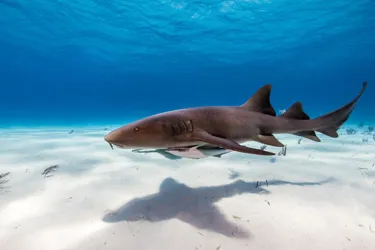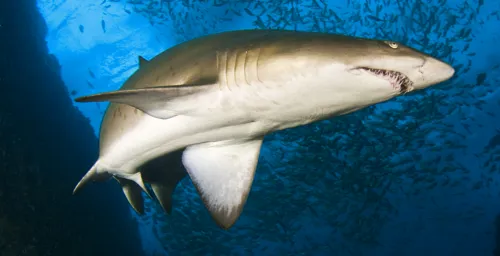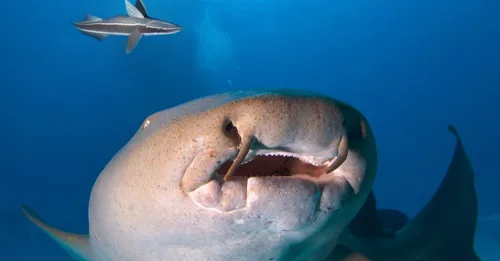Nurse sharks: facts & characteristics
- Thursday 20th July 2023

What are nurse sharks? Discover fascinating facts about nurse sharks and learn about common characteristics from Sea Life's expert guide. Dive in here!
What is a nurse shark? Interesting facts, characteristics and more!
- What is a nurse shark?
- Characteristics of a nurse shark
- 6 fun facts about nurse sharks
- Common misconceptions and myths
- Threats and conservation efforts for nurse sharks
- Where can I see nurse sharks
1. What is a nurse shark?
Nurse sharks are part of the Ginglymostomatidae family - they are slow-moving bottom-dwellers with two rounded dorsal fins, rounded pectoral fins and a broad head. They are also commonly referred to as sleeper sharks!
These sharks are typically found in tropical and subtropical waters in the Eastern Pacific, Western Atlantic and Eastern Atlantic.
Female nurse sharks average between 7.5 to 9 feet and are slightly larger than males. Adult nurse sharks have a light/dark brown colour whereas new-born nurse sharks have a spotted colouration. Their mouth is also filled with rows of serrated teeth that are quite small - they're perfect for crushing prey with hard shells.
Nurse sharks are estimated to live roughly up to 24 years and are a vital species for shark research.
2. Characteristics of a nurse shark
Types of nurse shark
It is good to note that there are different types of nurse shark, each with different characteristic and traits!
Grey nurse shark facts

- Grey nurse sharks are typically located in Australia, North America, South America, South Africa and Japan
- These sharks can grow up to 3.2 metres in length and weigh as much as 230 kg!
- Similar to humans, baby grey nurse sharks spend around 9 months developing in their mother's uterus
- They mainly eat lobster, crabs, squid or fish
- In the wild they can live up to 30 years old
- Grey nurse sharks are also known as sand tiger sharks due to their fearsome look. They have a mouth full of sharp teeth which are visible even when their mouth is closed!
- Contrary to their appearance, grey nurse sharks are actually quite docile, and not very aggressive
Tawny nurse shark facts

- Tawny nurse sharks are roughly between 1.3 to 2ft in length at birth - as they reach adulthood they are typically around 8.2 ft with a maximum length of 10.5ft
- They are typically found in the tropical Indo-Pacific Ocean ranging from South Africa to Australia, and several other areas including the Red Sea
- Reproduction - these sharks are ovoviviparous - the mother's eggs hatch inside her and her babies feed on the unfertilized eggs.
- Litter sizes are typically around 4 babies
- Tawny nurse sharks are typically nocturnal and search for prey during the night.
- Unfortunately, tawny nurse sharks are vulnerable worldwide due to heavy fishing pressure
What size are nurse sharks?
As previously mentioned, nurse sharks range anywhere from 7.5 to 8 feet long - however there have been reported cases of nurse sharks as big as 14 feet being found. There is currently speculation as to weather some of these larger reports closer to 15 feet have been exaggerated.
3. 6 fun facts about nurse sharks
- Origins of the Nurse Shark name - one of the most interesting things discussing nurse shark fun facts is there name and it's origin. There are different theories as to how these wonderful creatures got their name. True to some nurse shark characteristics, it has been suggested that their name may have derived from the sucking sound they can make when looking for prey. It's been suggested that this sound resembles the sound a nursing animal may make.
- Friendly creatures - despite their fearsome look, nurse sharks are friendly towards humans and not typically aggressive. It should be noted though, these animals can cause serious harm if they are disturbed or feel threatened. No fatal attacks on humans have ever been recorded.
- Feeling hungry? - nurse sharks typically feed on bottom-dwelling creatures including crabs, shrimp, snails and lobsters. They have a powerful suction system - meaning the way they feed is similar to that of a vacuum cleaner. Because of this, nurse sharks at times may leave their mouths open, waiting for critters to swim into their open jaw and unsuspectedly become dinner.
- Nurse sharks are unique to most sharks - for the majority of sharks, continuous swimming is essential to ensure their survival as they have to swim to breathe. However, another cool nurse shark characteristic is the special pump they have called a buccal pump! This pump works by pulling water.
- They love socialising - it is common for nurse sharks to group together, but the correct conditions must be present for this to happen. Scientists have reported groups of up to 40 nurse sharks being found resting on top of one another - this is most liking to facilitate mating. Nurse sharks can also be found resting in groups during the day.
- They're a colourful group - adult nurse sharks are typically brown but they can also be yellow or grey. However, in 1992 a "milk white" nurse shark was caught in Florida. It is thought that this nurse shark may have ha a genetic condition similar to albinism called piebald - which causes white patches of pigment-deficient white skin.
4. Common misconceptions and myths

Are nurse sharks dangerous?
This is a common misconception about these creatures - nurse sharks are typically not aggressive towards humans. According to recent reports, there have been around 51 provoked and 5 unprovoked attacks from nurse sharks before 2022.
Sharks are the ultimate predator
This common misconception is in fact untrue. Although sharks are apex predators, meaning within their marine ecosystem they are at the top of the food chain with few natural predators - the biggest threat to them is humans.
Illegal fishing has resulted in nurse sharks being killed for their fins. In certain parts of Asia, shark fin soup is also consumed - another cause for illegal trading.
Sharks are ale to detect a single drop of blood in the ocean
This is untrue, however it is a misconception held by many and can often lead to hysteria. Sharks have a highly accurate sense of smell and have the ability to detect miniscule quantities of certain chemicals - however this varies depending on the species of shark. Although some species can detect their prey at one part per 10 billion - the equivalent of one drop in an Olympic-size pool - this is no where near the same size as the entire ocean.
5. Threats and conservation efforts for nurse sharks
Various efforts are being made towards the conservation of nurse sharks.
The practice of shark finning is resulting in the death of huge numbers of sharks worldwide which various species including the grey nurse shark listed as one of the most critically endangered shark species.
SEA LIFE London Aquarium is currently supporting Bite-Back's latest campaign that aims to block the personal import of shark fins into Europe.
For more information about SEA LIFE London Aquarium's shark conservation efforts - visit our webpage: Shark & Marine Conservation | SEA LIFE London Aquarium (visitsealife.com)
6. Where can I see nurse sharks?
As previously mentioned, nurse sharks can be found in the tropical and subtropical waters of the Eastern Atlantic coast, Eastern Pacific and Western Atlantic.
However, people are encouraged to stay as far away from nurse sharks as possible and only observe them in their natural habitat to ensure you have a safe swimming experience.
At SEA LIFE London Aquarium you can meet these wonderful creatures along with various other shark specifies when you explore our Pacific Shipwrek!
There is also a wonderful shark walk on display where you can see these fin-tastic animals from a unique view.
Book Now